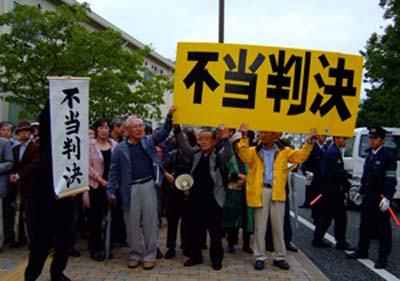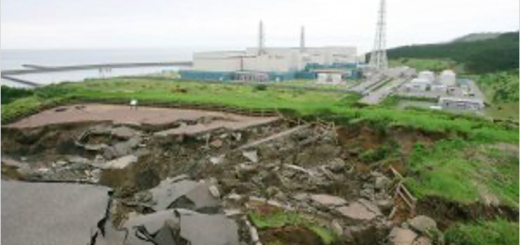Hamaoka Verdict: Passing Judgment on the Judge Nuke Info Tokyo No. 121
The Hamaoka nuclear power plant is safe. You can shake it, but you can’t break it. Thus wrote Judge Akira Miyaoka (long may his name be remembered) of the Shizuoka District Court in his 26 October “Nuclear Energy Day”(1) verdict.
 |
|
“Unjust Verdict”
|
The plaintiffs in this case are not so easily convinced. They have appeal the verdict to the Nagoya High Court. Indeed, it appears that even people who are generally favorable to nuclear power are skeptical. Japanese editorial writers’ ability to say nothing in 600 words is legendary, so the following comment in the conservative Nikkei Shimbun (27 October 2007) should be read as an expression of concern:
“The verdict will be a great relief for electric power companies, but Japan is a very earthquake-prone country, so it is necessary to continually take on board new knowledge concerning the earthquake resistance of nuclear facilities and to work to prevent anxiety arising among local residents and the general public.”
A more explicit criticism appeared in the Asahi Shimbun (29 October 2007):
“If the Tokai earthquake does indeed strike, how can we be sure that its intensity will be in the range that the authorities deem to be safe? The residents are far from relieved by the court decision … It seems that the court ruling places too much trust on the government’s safety standards, the nuclear plant’s quake-resistant design based on those government standards, as well as the plant’s actual operations.”
Background
A civil lawsuit demanding a temporary injunction to terminate the operation of Units 1-4 of the Hamaoka nuclear power plant was filed on 25 April 2002 and a regular lawsuit was filed on 3 July the following year. (Unit 5, which commenced operations in January 2005, was not covered by the suits.) The District Court’s verdict covers both suits. Had an injunction been granted, the defendant, Chubu Electric Power Company, would have been ordered to shut down the first four of its nuclear reactors. By contrast, the verdict demanding termination of operation of the Shika-2 NPP handed down on 24 March last year did not include an injunction, so the plant is allowed to continue operating without penalty while an appeal is heard (see NIT 112).
During the course of the trial, the plaintiffs provided detailed evidence regarding safety deficiencies and the dangers associated with earthquake-induced nuclear disasters (“gempatsu shinsai”). However, the court concluded that as long as the defendant’s safety assessment and safety checks were carried out in accordance with government regulations, all is well. The Japanese nuclear industry’s history of cover-ups and failures to identify and respond to safety-related problems did not prompt the court to question this dubious presumption. The historical record did not seem to register strongly in the mind of Judge Miyaoka.
High(low)lights from the verdict
- The court chose to ignore reports published in the media in September about the possibility that an earthquake even bigger than the predicted Tokai earthquake occurs in this region once every 1,000 years or so. This theory is based on evidence of previous massive earthquakes discovered by researchers through boring tests carried out near the Hamaoka NPP. Nevertheless, the court concluded that “the estimate of the earthquake movement is sufficiently conservative.”
- The court accepted the assessment based on the old earthquake resistance guidelines, even though new guidelines were issued last year in response to concerns about the adequacy of the old guidelines.
- The court rejected the possibility that multiple simultaneous failures could occur, despite the fact that such failures occurred at the Kashiwazaki-Kariwa NPP during the Chuetsu-Oki Earthquake (deformed pipes, cracks in buildings, a fire in a transformer, etc.). Instead, it stated, “It is not necessary to assume multiple simultaneous failures in the safety assessment” and “It is not possible to say that there is a realistic chance of multiple simultaneous deformation and rupture of pipes.”
- Concerning plant aging, the court disregarded the fact that it is impossible to predict where stress corrosion cracking will occur, or to inspect the full length of the piping. Instead, it concluded that the plant is safe as long as checks and inspections are carried out and parts are replaced appropriately.
- Over a period of five years, the plaintiffs presented evidence on a wide range of matters including the following: the type of earthquakes that should be taken into account (their scale and manner of occurrence); common-cause accidents arising as a result of earthquakes; the possibility of vast numbers of simultaneous failures; the plant’s safety margin; and the danger of aging of important equipment. The court dismissed all these as “various phenomena that are conceivable in the abstract”.
Assessment
One would have thought that it was not too difficult to imagine the cumulative safety risk of simultaneously occurring multiple pipe ruptures, emergency power supply failure, failure of control rods to insert and so on. The plaintiffs pointed out that simultaneous multiple failures such as these are precisely what one would expect in an earthquake. After the Hamaoka hearings ended, the Chuetsu-Oki Earthquake gave us a preview of the type of problems which might arise in the much larger earthquake that is predicted at Hamaoka. However, the court was unmoved.
Should a “gempatsu shinsai” disaster ever actually occur at Hamaoka, there can be no doubt about the seriousness of the consequences. Hamaoka is above the epicenter of the predicted Tokai earthquake, a huge earthquake caused by the collision of tectonic plates. Inevitably, such an earthquake will cause massive disruption to the emergency systems on which people would normally rely in the case of a major release of radioactivity. It will be impossible to evacuate most of the victims. They will be left with the dilemma of whether to stay indoors, or to brave the radiation and go outside to avoid being trapped inside crumbling buildings. Depending on the weather conditions, the radioactive fallout is likely to reach Tokyo, around 150 km East of Hamaoka. With a population of around 40 million, the Kanto Plain in which Tokyo is located is one of the most densely populated places on earth. A disaster on this scale has never been seen in human history. This is the nightmare that haunts the plaintiffs in the Hamaoka lawsuit. Not surprisingly, it will take more than Judge Miyaoka’s assurances of the plant’s safety to ensure they sleep peacefully.
CNIC takes the view that when making judgments about matters which have the potential to effect the health and safety of large numbers of people, it is necessary to consider the worst-case scenario and to take preventative measures. Society should adopt the precautionary principle as the basis for decision-making in such cases. This verdict follows a quite different principle. The principle on which it is based is “when in doubt go with the status quo”. Alternatively, this principle could be expressed as: “always follow the road of least resistance”.
We suspect that Judge Miyaoka was concerned about the wider ramifications of his verdict – for nuclear power in Japan and possibly at a more personal level as well. Perhaps some people will sympathize with him. How could we expect a judge in a minor regional court, ill-qualified in such technical matters, to deliver a verdict that, besides closing down the Hamaoka nuclear power plant, would inevitably provoke calls for the closure of nuclear power plants around the whole country? Some might ask what difference it makes anyway. After all, this case was always going to go all the way to the Supreme Court.
In the end, the judgment we make comes down to the underlying belief systems from which we operate. Those of us who believe in following the precautionary principle would judge that a disaster worth preventing is worth preventing sooner rather than later. On the other hand, those who believe in following the path of least resistance might congratulate Judge Miyaoka for making a career-wise decision. Of course, those people might not be quite so understanding if a “gempatsu shinsai” disaster occurs between now and the appeal court’s verdict.
Philip White (NIT Editor)
1. The nuclear club in Japan commemorates 26 October as “Nuclear Power Day”. On that day in 1963, at the Japanese Power Demonstration Reactor, Japan generated electricity from nuclear power for the first time. No one else takes any notice of this day, except the opponents of nuclear energy, who call it “Anti-Nuclear Power Day”.




